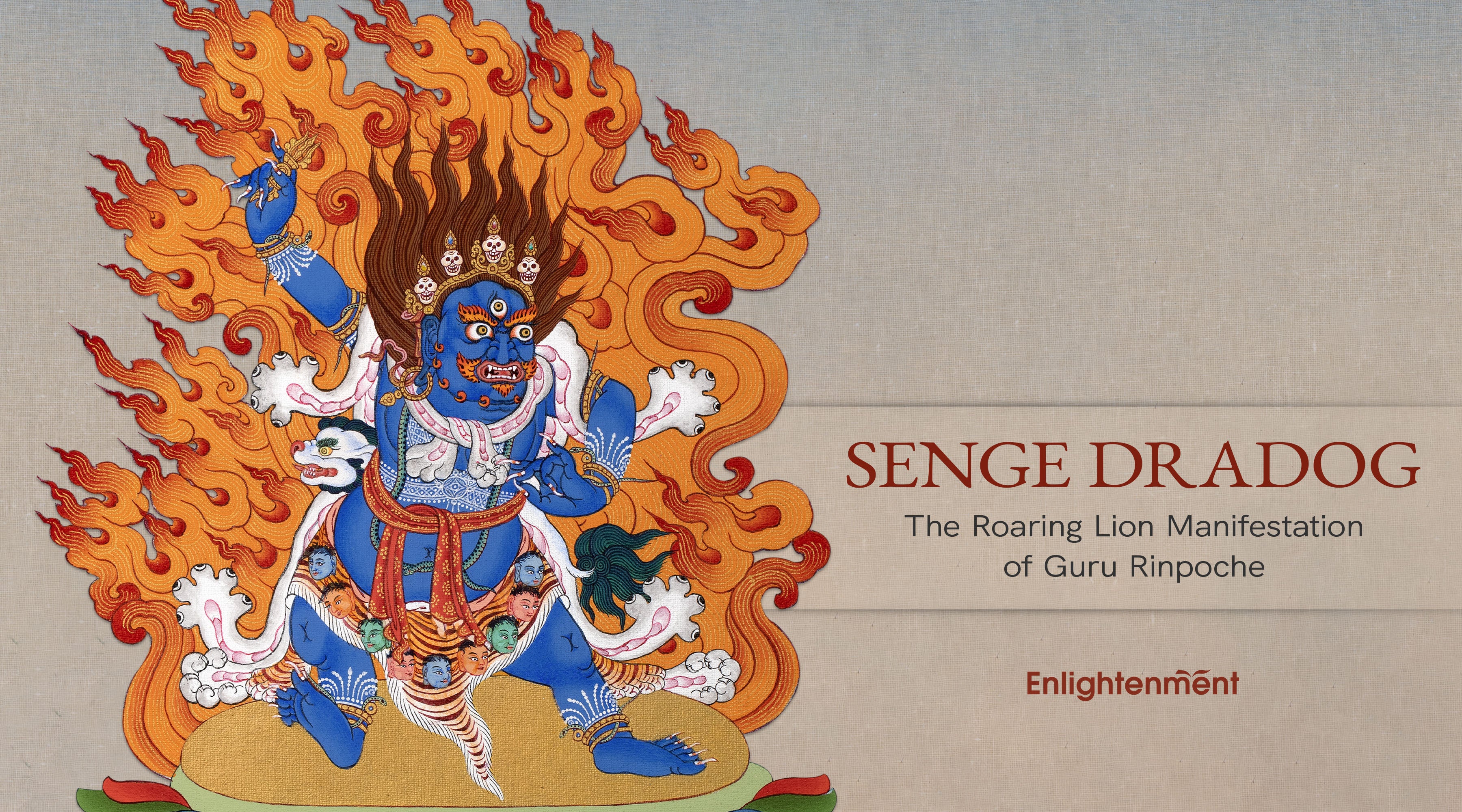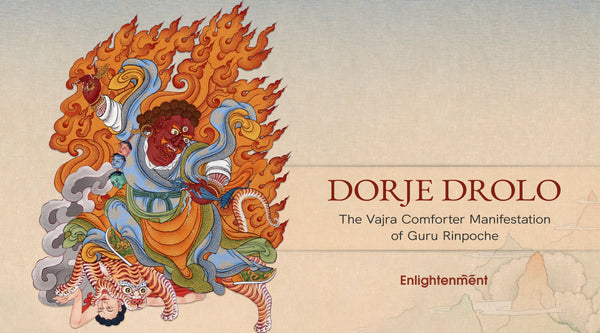Exploring the Spiritual Journey of Senge Dradog
Senge Dradog is another consequential wrathful manifestation of Guru Rinpoche. He is extensively called the "Lion’s Roar." since he embodies the powerful, protective, and fierce aspect of the Precious Master. The Guru is worshipped as the "Second Buddha" in Tibetan Buddhism. Guru Padmasambhava and Samye Dorje are some of his other names that are widely prevalent in Vajrayana Buddhism.
Out of his other eight manifestations, Singye Dradog’s manifestation is closely associated with the removal of obstacles, protection against hostile forces, and the destruction of ignorance. All of the divine and pious forms taken by the revered Guru Rinpoche are mentioned below:
- Shakya Senge
- Pema Gyalpo
- Nyima Odzer
- Dorje Drolo
- Senge Dradog
- Lodan Chokse
- Pema Jungne
- Urgyan Dorje Chang

Guru Dradog stands out as a powerful and wrathful protector deity, while possessing the fierce compassion of Samye Dorje. This form is not merely symbolic; it represents a dynamic force that destroys ignorance, subdues negative energies, and guides practitioners on the path to enlightenment.
Senge Dradog Origin Story
Senge Dradog originated from Guru Rinpoche as one of his eight forms to fight the evil powers befitting the situation. Hence, his origin is deeply intertwined with the life of Guru Padmasambhava. According to one legend, once a big philosophical debate occurred in Bodhgaya, where hundreds of anti-Buddha scholars defeated Buddhist scholars. The event harmed the essence of Buddhism, while the adharma showed influence over the sentient beings.
Samye Dorje appeared and challenged the anti-Buddhists, and he effortlessly defeated them. However, the losing debaters were unhappy and unsatisfied with their humiliating losing result. Thus, they resorted to the use of black magic to harm the Buddhists. That was when Guru Rinpoche took the form of the fierce and wrathful yet dharma yogi Singye Dradog to fight them off.
Guru Singye is believed to have called upon the immense tantric power of Dakini Bud 'dul ma, which enabled him to summon tremendous lightning bolts from the sky. The anti-Buddhists were punished, and their city was destroyed to stop their use of black magic. When the wrath finally stopped, the anti-Buddhists converted to Buddhism and asked for forgiveness for their unethical ways of treating other beings. Thus, Guru Rinpoche once again restored Dharma, peace, and Buddhism.
Senge Dradog Iconography and Symbolism In Himalayan Art
The depiction of Senge Dradog is rich in symbolism, each element conveying profound spiritual meanings. He is also one of the few among other Guru Samye manifestation forms to be worshipped as an individual deity. In terms of art, various reasons make him stand out among the abundant Vajrayana deities.
In majority of the arts, including thangkas, Guru Dradog stands on a gold sun disc which rests upon a lotus flower atop a Vajra Rock. His feet trample both a male and a female body. He also maintains quite a unique posture where his left leg is extended front.
The list here below highlights the notable part of a Guru Senge Dradog thangka:
- Three Eyes and a Wrathful Appearance
- The Tiger Skin Loincloth and Bone Ornaments
- Vajra In Right Hand
- The Roar of Enlightened Speech
- His Four Disciples

Three Eyes and a Wrathful Appearance
Senge Dradog’s wrathful appearance should not be misunderstood as anger in the conventional sense. In Vajrayana Buddhism, wrathful deities like Guru Singye represent the compassionate ferocity necessary to destroy negative forces. His fierce expression and three eyes are intended to show that he is a knower of all three times—past, present, and future—as the protector of the Dharma.
Hence, he is ready to annihilate any obstacles that stand in the way of spiritual progress. All these are depicted around the fierce, wrathful yet serene, and natural ambiance. Meanwhile, the big fire behind him is fierce but it leaps upwards and outwards with abundant smoke to signify his unparalleled power.
The Tiger Skin Loincloth and Bone Ornaments
On his dark blue skin complexion, Guru Dradog wears a tiger skin loincloth on his waist. He also wears an elephant hide and lion skin on his back; these materials signify his connection with nature. His iconic art also features some intricate bone and gold ornaments all over his body, including a garland of human heads and poisonous snakes around his neck.
Guru Dradog bears a gold diadem of five skulls on his head, where his long hair of gold streaks flows elegantly. These extraordinary accessories fit his muscular and large appearance, topped up by his three eyes and his wrathful facial expression.
Vajra In Right Hand
Guru Senge holds a Vajra in his right hand as if he is about to strike it. His left hand is bent towards his body in a threatening gesture, which signifies his mastery over his powerful weapon. He knows when and where to strike the thunderbolt and make the best out of his attack.
The Roar of Enlightened Speech
The most defining feature of Singye Dradog is his roar. This is not an ordinary sound but a manifestation of enlightened speech. According to Buddhist teachings, the word of an enlightened being has the power to destroy ignorance, guide beings to the truth, and liberate them from suffering. His roar is symbolic of this liberating force, a sound that reverberates through the cosmos, dispelling the darkness of ignorance.
His Five Disciples
Guru Singye is surrounded by intricate, detailed, and natural elements in art. The most notable people around him are his beloved disciples called Rigzins. The first Rigzin Trabha Hati sits at the top. He is known as the one who passed one of the lineage of the Eight Doctrines of the Nyingma sect to his Guru.
The second Rigzin is Palge Dorje, who had the power to pass through rocks comfortably. The third Rigzin is Ma-Thong Rinchen, who possessed the power to consume rocks as food and survive that way. The fourth Rigzin in the thangka is Palge Singay who was able to summon the eight classes of spirits at will. Among such miracles-performing students, the last one had the power to swim perfectly like a fish. And this Rigzin was named Oden Wangchuk. Hence, he is depicted in a wild yet foaming river.
Senge Dradog in Contemporary Practice
Senge Dradog is considered an important figure in Tibetan Buddhism, especially within the Nyingma school, which traces its lineage directly to Guru Rinpoche. His images are found in monasteries, prayer flags, and thangkas to honor him and invoke him for seeking protection and the removal of obstacles.
He is more than just a wrathful deity; he is a manifestation of Guru Rinpoche’s enlightened activity and a powerful protector of the Dharma. His origins are rooted in the history of Tibetan Buddhism, where he played a crucial role in overcoming the obstacles that threatened the establishment of Buddhist teachings in Tibet.
Guru Dradog remains a vital figure for practitioners who worship him for embodying the fierce compassion needed to confront and overcome the challenges on the path to enlightenment. Through his lion-like form, fearsome appearance, and thunderous roar, Singye Dradog continues to inspire and protect those who seek to cultivate the same fearless dedication to the Dharma in their own lives.


